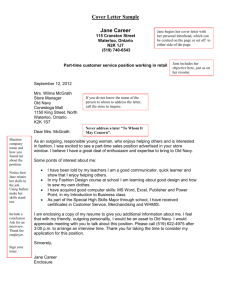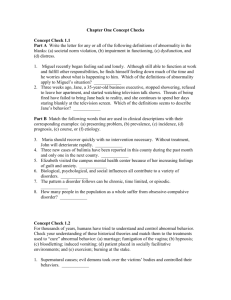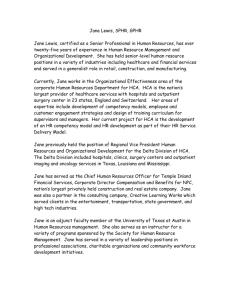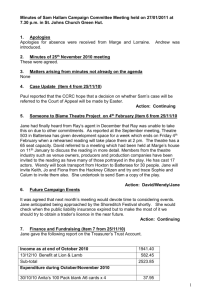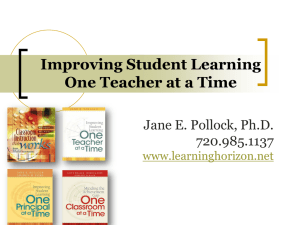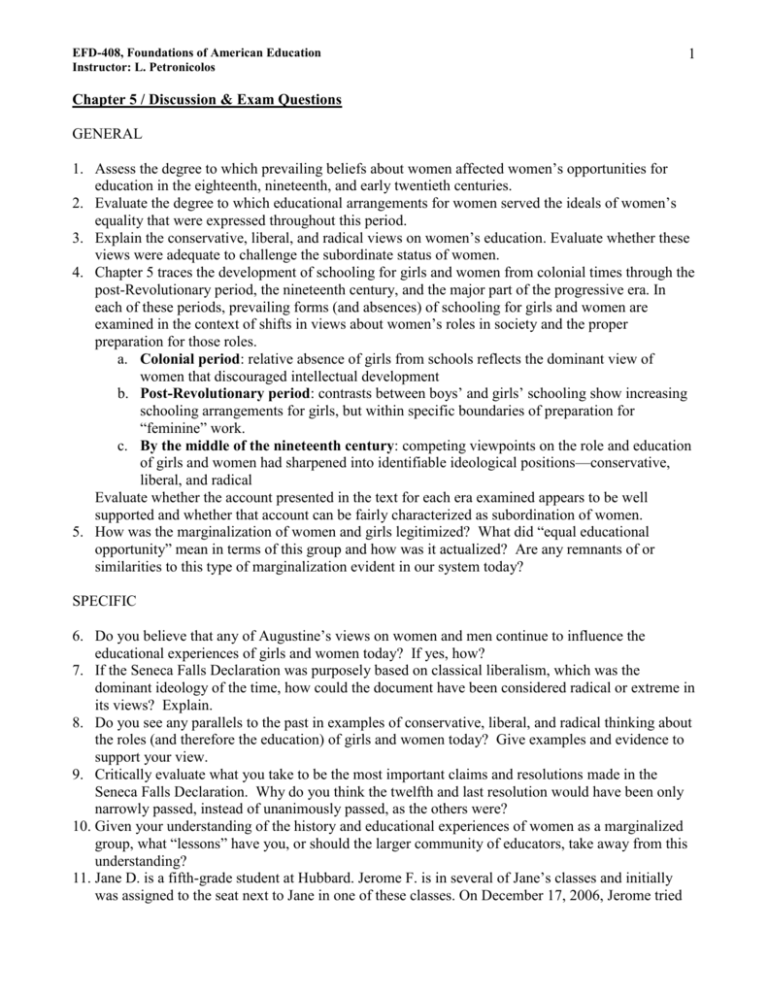
EFD-408, Foundations of American Education
Instructor: L. Petronicolos
1
Chapter 5 / Discussion & Exam Questions
GENERAL
1. Assess the degree to which prevailing beliefs about women affected women’s opportunities for
education in the eighteenth, nineteenth, and early twentieth centuries.
2. Evaluate the degree to which educational arrangements for women served the ideals of women’s
equality that were expressed throughout this period.
3. Explain the conservative, liberal, and radical views on women’s education. Evaluate whether these
views were adequate to challenge the subordinate status of women.
4. Chapter 5 traces the development of schooling for girls and women from colonial times through the
post-Revolutionary period, the nineteenth century, and the major part of the progressive era. In
each of these periods, prevailing forms (and absences) of schooling for girls and women are
examined in the context of shifts in views about women’s roles in society and the proper
preparation for those roles.
a. Colonial period: relative absence of girls from schools reflects the dominant view of
women that discouraged intellectual development
b. Post-Revolutionary period: contrasts between boys’ and girls’ schooling show increasing
schooling arrangements for girls, but within specific boundaries of preparation for
“feminine” work.
c. By the middle of the nineteenth century: competing viewpoints on the role and education
of girls and women had sharpened into identifiable ideological positions—conservative,
liberal, and radical
Evaluate whether the account presented in the text for each era examined appears to be well
supported and whether that account can be fairly characterized as subordination of women.
5. How was the marginalization of women and girls legitimized? What did “equal educational
opportunity” mean in terms of this group and how was it actualized? Are any remnants of or
similarities to this type of marginalization evident in our system today?
SPECIFIC
6. Do you believe that any of Augustine’s views on women and men continue to influence the
educational experiences of girls and women today? If yes, how?
7. If the Seneca Falls Declaration was purposely based on classical liberalism, which was the
dominant ideology of the time, how could the document have been considered radical or extreme in
its views? Explain.
8. Do you see any parallels to the past in examples of conservative, liberal, and radical thinking about
the roles (and therefore the education) of girls and women today? Give examples and evidence to
support your view.
9. Critically evaluate what you take to be the most important claims and resolutions made in the
Seneca Falls Declaration. Why do you think the twelfth and last resolution would have been only
narrowly passed, instead of unanimously passed, as the others were?
10. Given your understanding of the history and educational experiences of women as a marginalized
group, what “lessons” have you, or should the larger community of educators, take away from this
understanding?
11. Jane D. is a fifth-grade student at Hubbard. Jerome F. is in several of Jane’s classes and initially
was assigned to the seat next to Jane in one of these classes. On December 17, 2006, Jerome tried
EFD-408, Foundations of American Education
Instructor: L. Petronicolos
2
to touch Jane’s breasts. He also directed vulgarities at Jane, such as “I want to get in bed with you”
and “I want to feel your boobs.” Jane complained to her teacher, Mr. Fort. After school that day,
Jane also told her mother about Jerome’s behavior. The next day, her mother called Mr. Fort to
discuss the incident. Mr. Fort told Jane’s mother that he had allowed Jane to change assigned seats
away from Jerome and that Principal Querry was notified about the incident. However, for the next
four months, Jerome continued to harass Jane and behave in a sexually suggestive manner toward
her during their classes, including the physical education class. Eventually, Jane’s mother decided
to file for a complaint against the school and the school board for a violation of Title IX. Does Title
IX allows a claim against a school board based on school officials’ failure to remedy a known
hostile environment caused by the sexual harassment of one student by another (“student-student
sexual harassment”)?


